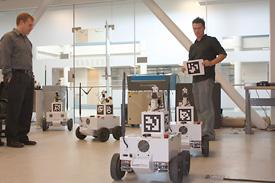Robotics Day 2012
• 9 a.m.-5:15 p.m. April 9, North Campus Research Complex, Building 18.
• The event is free and open to the public.
Watch it
Robotic taxis could transform transportation — saving time, energy and even lives, Professor of Engineering Practice Lawrence Burns says.
At the upcoming Robotics Day 2012, the former GM vice president for research and development will share his vision for what he calls sustainable mobility. It is centered around a network of lightweight, self-driving, shared automobiles that don’t take up space in parking lots and invite passengers to catch up on email or texts en route. (You wouldn’t be distracted by having to drive, he says.)
Burns is the keynote speaker at this event that showcases cutting-edge robotics research going on at U-M, at other Michigan universities and in government and industry. Sen. Carl Levin will speak at 9 a.m.
Anchored by Michigan Engineering, the Detroit automotive base, and the Army’s Tank Automotive Research, Development and Engineering Center, southeast Michigan is a hotbed of activity in this growing field. It’s a field whose practical applications are coming of age, says Professor of Mechanical Engineering Dawn Tilbury, director of U-M’s Ground Robotics Reliability Center.
“The sensing technologies in robotics are coming to the point where you can use these things in the real world,” Tilbury says. “Ten years ago, it was hard to have the robot understand where it was in the world, and that’s important. Now, the evolution of sensors is making this possible.”

Computer science and engineering doctoral student Ryan Morton demonstrates how the robots follow him when he shows them black and white commands on a sheet of paper while team adviser Edwin Olson looks on. These robots will be on display at Robotics Day 2012 on April 9 at the North Campus Research Complex. Photo by Nicole Casal Moore.
Michigan Engineering researchers are making machines that walk, run, fly, roll, swim and slither, and with applications as varied as their mode of transport. Others, such as prosthetic devices and surgical tools, stay still but enhance human capabilities in big ways. Many of these technologies will be on display or demonstrated at Robotics Day, including:
• A smart swarm of unmanned, four-wheeled bots that won an international urban reconnaissance contest in 2010. These MAGIC robots were created in the lab of Assistant Professor of Electrical Engineering and Computer Science Edwin Olson.
• An intelligent wheelchair designed to navigate planned routes as well as detect and avoid obstacles. Professor of Computer Science and Engineering Benjamin Kuipers is developing this.
• A remote-controlled Segway robot that’s mapping North Campus in four dimensions. Developed by Nick Carlevaris-Bianco, a doctoral student in Assistant Professor of Naval Architecture and Marine Engineering Ryan Eustice’s Perceptual Robotics Lab, it uses a camera and a laser scanner to gather information about how the environment changes over time due to construction, traffic, weather, day and night, as well as seasons. The project’s goal is to develop an instrumented camera that could know precisely where it is. Watch a demonstration video at www.youtube.com/watch?v=wfQryD76fyg.
Toyota and Ford are two industry participants that will display autonomous vehicles that take a step toward the future that Burns envisions. His talk, Reinventing the Automobile, is at 3:30 p.m.
Our current driving habits and infrastructure are unsustainable, Burns says, from an energy, space, traffic congestion and safety perspective.
“1.2 million people a year are dying on roadways,” Burns says. “That’s epidemic in scale, and the causes of the crashes can trace back to the people driving the machines. Self-driving cars can take the crash out of the equation, so they could be much lighter and more efficient.”
He imagines a future where robotic vehicles chauffer passengers, getting their routes from a “mobility Internet” not too different from goods movement or advanced taxi dispatch systems. These cars would spend most of their time on the road, rather than parked in a lot or a driveway.
“It’s an exciting future,” he says. “The opportunities are profound if we begin to connect these dots.”
Organizers expect close to 300 people at Robotics Day, from 9 a.m.-5:15 p.m. April 9 at the North Campus Research Complex, Building 18. It is free and open to the public. Register at www.mirobotics.org/index.php/registration. The event is sponsored by U-M and the National Center for Manufacturing Sciences.

